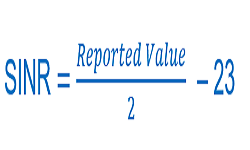Introduction
SINR is Singal to Interference Noise Ratio is a measure of signal quality. It can be defined as the ratio of wanted signal strength and the unwanted interference plus noise.
Good SINR can help to achieve higher spectral efficiency as it enable to decode higher Modulation Conding Scheme (MCS). The network operator always seeks to maximize SINR at all sites to deliver the best possible User Experience, either by transmitting at a higher power, or by minimizing the interference and noise. As per the Shannon’s Channels Capacity (C), the theoretical Channel Capcity is a function of bandwidth (B) and is a function of the SINR.
Thus, optimizing SINR can helps to achieve high Cell Capacity, allows higher order QAM modulation, resulting in higher peak data rates, fewer dropped calls, and ultimately improved User Experience.
SINR in 5G NR
5G NR has defined following two types of SINR
- SS-SINR: It is Synchronisation Signal – SINR meausrement and can be used for connected mode mobility procedures (Handovers). Both the wanted signal power and the interference plus noise power are measured from REs used by the Secondary Synchronisation Signal (SSS)
- CSI-SINR: It is CSI Reference Signal – SINR measurement and similar to SS-SINR it can also be used for connected mode mobility procedures. Here wanted signal power and the interference plus noise power are measured from REs used by the CSI Reference Signals
5G NR SINR Key Pointers
- SS-SINR is an optional UE capability which UE must declare separately for FR#1 and FR#2
- UE uses the ss-SINR-Meas flag for SS-SINR and csi-SINR-Meas flag for CSI-SINR within the MeasAndMobParametersFRX-Diff parameter structure to signal its capability for SS-SINR
- UE measures PBCH Demodulation Reference Signal (DMRS) when generating SS-SINR results
- UE measures CSI Reference Signal transmissions on antenna port 3000 when providing CSI-SINR measurement
- In 5G networks is SINR reported as a coded value via measurement report to gNB
- 3GPP specification 38.133 specifies the mappings between the reported and measured values
- The reported range is from 0 to 127, total 128 values where reported value 0 is equal to SINR <-23 dB and value 127 represents SINR > 40dB
- 3GPP specification has provided SINR resolution of 0.5 dB while reporting the measurement
SINR and Reported Value Mapping
Following table shows the mappings between the reported and measured values for SINR. This table is applicable to both SS-SINR and CSI-SINR.
Calculating SINR with Example:
Following formula can be used to calculate the SINR value in dB using the reported value by UE within measurement report.
-
- UE Reported SINR Index Value = 73
- SINR (in dB) = 73/2 -23 = 36.5 – 23
- SINR (in dB) = 13.5 dB
Reference
- 3GPP TS 38.215: 5G NR; Physical layer measurements
- 3GPP TS 38.213:5G NR; Physical layer procedures for control channels
- 3GPP TS 38.214: 5G NR; Physical layer procedures for data channels
Related Posts
- 5G NR Measurements: RSRP, RSSI, RSRQ and SINR
- 5G NR SS-RSRP Value Measurement Mapping
- 5G NR RSRQ Measurement and Mapping
- 5G NR RRM Measurement Requirements
- 5G NR Measurement – Serving Cell and Neighbor Cell

